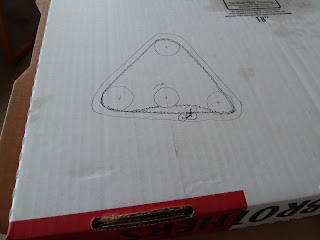One thing you don't realize when you relocate for a significant amount of time, is all the little things you're used to having access to. For example, usually when I do any design work I like having paper around to make sure what's in my head can actually be drawn and physically embodied. Well, I don't have any paper here, but we do have some old pizza boxes lying around...
Here was the original idea, of bringing the belt to the motor
And here would be some servo mechanism to tension the belt
What's this, moving the motor to the belt. Is this opposite day? No, it's fire day...
Now whenever somebody says to do envelope calculations, I'm going to do them on a pizza box, so much more room! Anyways, a few minutes into my brainstorming session I realized that my original plan of bringing the belt to a fixed motor was going to be difficult. Initially I wanted to do something like this:
The second spring isn't shown, but if it were the servo would have a neutral point where the spring displacements are equal and thus F1 = F2. This way, the servo could be floating during driving (tension) and the spring (F2) could do all the work. Then, when you need to detension, the servo arm would rotate downwards. However, this gets complicated when trying to load the pin that the tensioner bearings are riding on. This pin would require a slot on both of the plates that sandwich the wheels, and if the spring forces on either side weren't perfectly balanced the pin would tilt and not tension very well.
At this point, I thought back to my real first idea, which was to have the motor on a pivot. I threw out that idea originally because I didn't like having a motor that's not rigid with the frame (and I still don't). Practically though, this is a lot simpler because a motor itself does not rotate like a belt does -you can't bolt anything to a belt. So, that's where my third pizza box drawing comes in, which looks like this in SolidWorks form:
Most of the drivetrain complete
Better shot of the motor mount plate
View of the drivetrain from the inside where the electronics will eventually sit
This of course had it's own challenges. The primary difficulty was making a robust mounting system for the motor that would withstand the torque from the belt tension on a single pin! To that end, the motor is centered as much as possible so that it's entire mass isn't cantilevered. The plate that carries the motor will serve as one washer of a thrust bearing, the other will be the inner plate, and a matching thrust bearing on the other side. Thrust bearings can take a lot of lateral load, these ones are rated to about 26lbs and were the only ones on McMaster small enough for the task. This picture should clarify what that actually looks like:
In the middle of the frame you can see the darker grey thrust bearings sandwiching the inner plate. To get everything to fit and not interfere (still not entirely done with that) took a lot of geometry and trial and error. Probably took more time to dimension this plate than design all of the electronics.
Not including the servo or supports to keep the inner and outer plates together.
There are several advantages to this design. Firstly, due to the way the motors are mounted there is more room in the middle section for the electronics and battery to sit. I'm still playing with the tray that will mount all of that but I'm going to do my best to make TOBL2 narrower -this would make driving a lot more controlled. Unlike the original design, I don't have to worry as much about the springs. As you can see above on the shots of the drivetrain in its entirety, there are holes galore on the motor mounting plate, both to accept some sort of turnbuckle from the servo and a spring(s) to maintain belt tension. Having all these mounting options will be important in finding the perfect spring displacement which keeps tension in normal and 60 degree mode, but also isn't too strong for the servo to de-clutch. Next step: figure out the supports which hold the two drivetrains together and carry the electronics. Maybe tomorrow will be a fire day too?










No comments:
Post a Comment